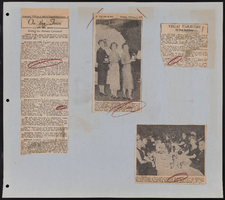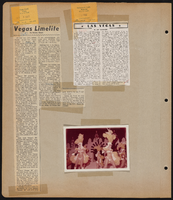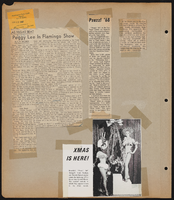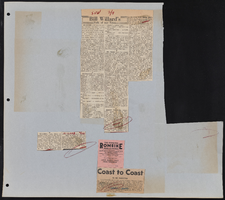Search the Special Collections and Archives Portal
Search Results
Garwood and Joan Van Family Papers
Identifier
Abstract
The Garwood and Joan Van Family Papers (1920-2003) contain scrapbooks, photographs, newsletters, correspondence, and newspaper clippings collected by Garwood Van and his wife Joan Van.The collection includes material on Garwood's music career as a popular band leader in New York, California, and Las Vegas, Nevada as well as material about Joan's early life as a model and dancing career.
Archival Collection
Matt Gregory Photograph Collection
Identifier
Abstract
The Matt Gregory Photograph Collection contains color and black-and-white photographic prints, negatives, and slides of musical and dance shows he produced in Nevada and international locations between 1959 and 1985.
Archival Collection
Kent Carmichael oral history interview
Identifier
Abstract
Oral history interview with Kent Carmichael conducted by Stefani Evans on November 25 and December 2, 2019 for the Boyer Early Las Vegas Oral History Project.
In the first session of this oral history, Carmichael discusses his early career in lighting design and maintenance from his start at Interstate Neon to his work in the 1950s and 60s in Las Vegas. He discusses some of the iconic signs he built including the Casino Center, Carnival Room, Thunderbird, The Frontier, Bonanza, and the Stardust. He also details the technology and inner workings of these innovative signs including the transition from mechanical to electrically controlled signage. Carmichael continues to discuss Native American laborers and various individuals that he interacted with throughout his early career including Max and Mo Oggenblick, Doby Doc, Benny Binion, Arby Alper, Steve Wynn, Peter Arp, and Wayne and Jerry Newton. Carmichael ends the first interview by recalling a high wind event that damaged the Frontier sign and his efforts to bring the sign under control and repair it as well as his vision and behind the Stardust sign.
The second oral history interview contains Carmichael’s discussion of his career from 1968 onward. He immediately picks up discussion of the Stardust sign and his transition to desk work. Carmichael details the challenge and limitations of designing the International sign (the Westgate as of 2021). He describes the development of his first messenger sign for the International and the time consuming task of using tape to program the sign. He fondly remembers working on the Holiday Inn Riverboat signs, and International transition to Las Vegas Hilton and the Hilton’s transition from blue to red letters. Carmichael shares the story of being caught between organized crime and a young Steve Wynn. He recounts his last project for Ad Art, developing and construction the sign for the Louisiana Superdome in New Orleans, Louisiana. He details working through legislative and construction issues as well as the fallout from the Nat Kiefer Commission.
After leaving Ad Art Carmichael began working with Heath and Co. and began collaborating with Raul Rodriguez. Carmichael and Rodriguez went on to design some of the most enduring and visually unique signs in Las Vegas including, the Flamingo, Four Queens, Golden Nugget, Dunes Hotel, and the Desert Inn. They also worked in Reno on Circus Circus and El Dorado. Carmichael also details his interior work including the main pylon and interior signs for MGM Grand; 1974 renovation Golden Nugget, suspended stained glass ceiling at Tropicana, and the MGM Lion display. Lastly Carmichael outlined his work with Young Electric Sign 1983-85 and the Dewey Sign Company including the Las Vegas Convention Center sign. He ends by sharing his views on the role and importance of lighting in Las Vegas.
Archival Collection
"Let's Go A-Go-Go" act performing on the Strip and touring Caesars Palace under construction: video
Date
Archival Collection
Description
Static view of the Hacienda Horse and Rider sign; cuts to the "Let's Go A-Go-Go" performers talking and then viewing the Las Vegas Strip from a balcony at The Dunes. Behind the performers, parts of the Strip can be seen including The Sands, The Sahara, Guardian Angel Cathedral, The Desert Inn, and downtown in the distance. Other sequences show the Flamingo and the Dunes sign from the elevated viewpoint. Cuts to Caesars Palace construction site where owner Jay Sarno leads a tour through the property; Sarno walks the group through the pool area where construction laborers work on the just poured swimming pool. Footage then cuts to a dressing room scenes as women apply makeup followed by clips from a performance in various outfits. Footage then cuts to the Hacienda pool where the act meets with Hacienda Casino owner Judy Bailey; group is filmed near the Thunderbird Casino driving away in a Corvette. Footage also shows The Riviera marquee featuring an ad for Betty Grable starring in Hello Dolly with smaller acts touted including Shecky Greene, Tony Sandler, and Ralph Young. Original media 16mm, b/w, aspect ratio 4 x 3, frame size 2048 x 1556. From The Production Company Audiovisual Collection (MS-00930) -- Digitized audiovisual material file.
Moving Image






